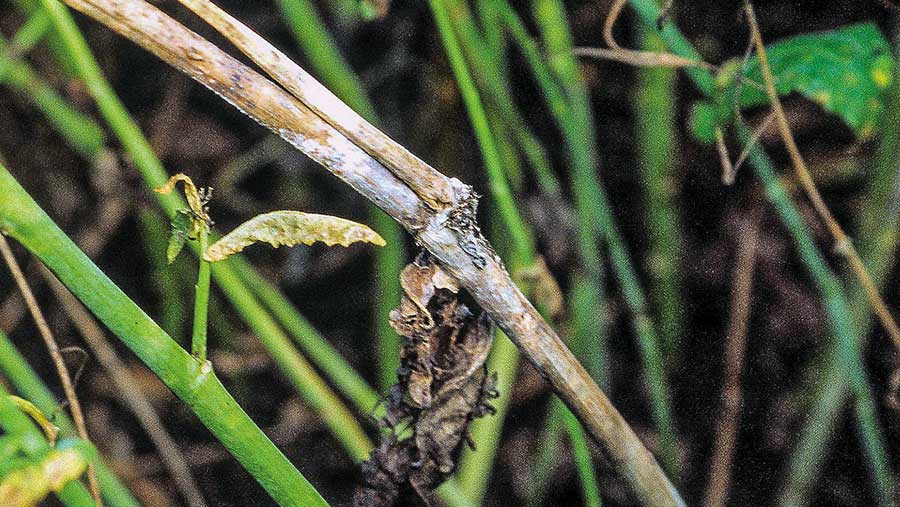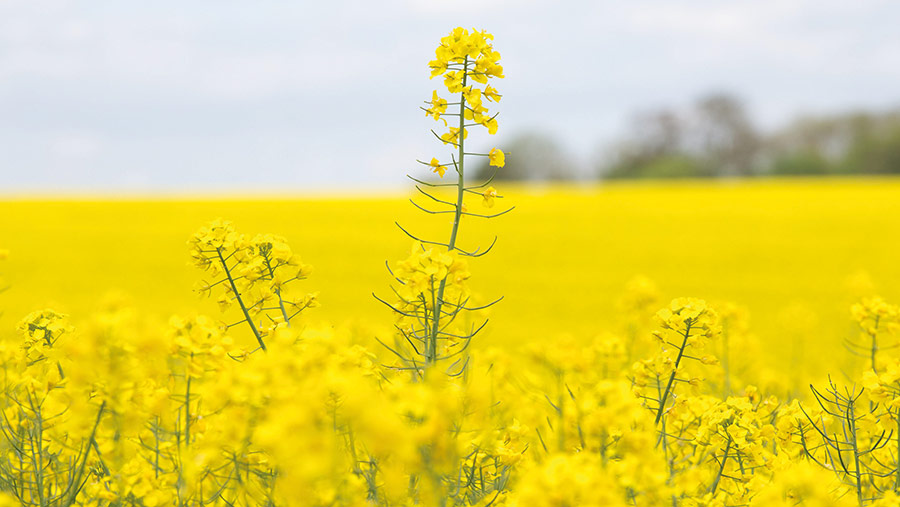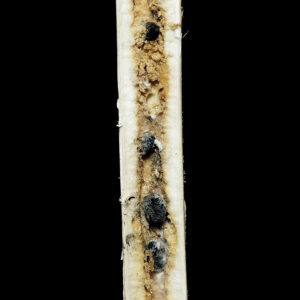Sclerotinia-tolerant OSR set to reduce flowering sprays
 © Martyn Cox/Blackthorne Arable
© Martyn Cox/Blackthorne Arable Strong demand is expected for the first oilseed rape variety showing sclerotinia disease tolerance, with enough seed available this summer to drill 2.5% of the rapeseed area.
The new hybrid variety shows tolerance rather than total resistance to the stem rot disease, but it may, in future, limit the number of flowering fungicide sprays used on crops.
This breakthrough variety, PT303, comes from breeder Pioneer, which is part of agrochemical and seeds giant Corteva Agriscience. It is the top-yielding variety vying for inclusion in the next AHDB Recommended List.
Andy Stainthorpe, Corteva seed and inoculants sales manager, says there should be enough seed for 5% of the hybrid market, or 2.5% of the total oilseed rape market, assuming a 50-50 split between hybrid and conventional varieties.
“For those farmers wanting to try some PT303 this summer, we should be able to cater for them,” he says.
See also: Why Holl oilseed rape is working for winning grower
Multi-gene trait
The variety with the multi-gene tolerance trait is now registered in the EU, so there could be good demand from growers in continental Europe, as well as in the UK this summer.
In addition to the genetic disease tolerance, the variety has a plant structure designed to limit sclerotinia. This is because it has fewer branches below the crop canopy, which allows better air circulation through the crop and so reduces humidity, which is a key requirement for the disease to develop quickly.
Sclerotinia is the main disease threat during the flowering stages of oilseed rape, as it can halve yields in bad infection years, and warm and humid weather at flowering helps its spread.
The disease shows up as white stem lesions with black sclerotia within the plant’s stem cavity, which cuts off nutrient supplies to the crop canopy. In extreme cases the whole plant dies.
The disease develops when night temperature are higher than 7C and day temperature are over 12C for a 24-hour period, combined with relative humidity being more than 80% for three consecutive days.

© Tim Scrivener
Top yielder
Mr Stainthorpe says the new tolerance or partial resistance trait does not come at the expense of other essential features, such as yield, as it has proved the top yielder in official trials.
“The new variety comes with a new trait and also a top yield,” he says, adding that when new traits come to the market, they often come with a yield penalty.
In Recommended List trials, variety PT303 gave a gross output yield of 111% compared with control varieties such as Expansion (104%), Alizze (99%), Campus (103%) and Elgar (98%). PT303 was the top yielder in both the East/West and North regions.
It is slightly taller than these other varieties, but has a similar resistance score for lodging and good disease resistance scores for light leaf spot (6) and phoma stem canker (7), on a 1-9 scale where 1 is susceptible and 9 shows good resistance.
The new variety is also resistant to turnip yellows virus, and has a very high oil content of 46.2%, which is only matched by Dazzler, with a similar level on the current Recommended List.

© Martyn Cox/Blackthorn Arable
Candidate variety
The variety joined the National List in January 2021, and scored higher for early vigour growth than the control varieties, with a score of 6 compared with Expansion at 5.8 and Campus at 5.5 in the 2019-20 season
Although the trait does not give 100% resistance to the yield-sapping disease, agronomists say it could reduce spraying, or even cut out flowering sprays altogether in very dry springs.
However, with global warming and the resultant increase in wet and humid weather, sclerotinia could become a bigger burden for growers, and although it only strikes seriously once every few years, when it does, the disease is hugely damaging to yield.
Short rotations and conducive weather help its spread, and seasonal infection risk alerts are issued by the AHDB. However, the spraying of a tall, flowering crop is always difficult, particularly to avoid potential harm to bees.
Therefore, longer oilseed rape rotations and avoiding fields with a history of previous sclerotinia infection are advised.
The best spray timing is just before mid-flowering on the main stem and before significant petal fall, and fungicides can give good control for about three weeks. However, two sprays may be need to protect crops at high-risk sites and when the flowering period is extended.
Useful trait
David Leaper, seed technical manager at agronomy group Agrii, says this is another very useful trait from plant breeders following others such as turnip yellows virus resistance and phoma resistance.
He suggests the new sclerotinia tolerance could be particularly useful to reduce the risk of disease in an extended flowering period in oilseed rape and with unsettled weather.
Andrew Melton, a Norfolk-based agronomist with Frontier, says the variety could be particularly useful for those who follow integrated pest management regimes and only use pesticides when they are really needed.
“Any oilseed rape variety that offers sclerotinia tolerance – we would have to take a close look at it,” he says.

